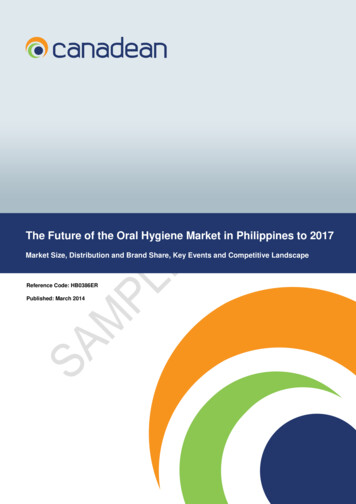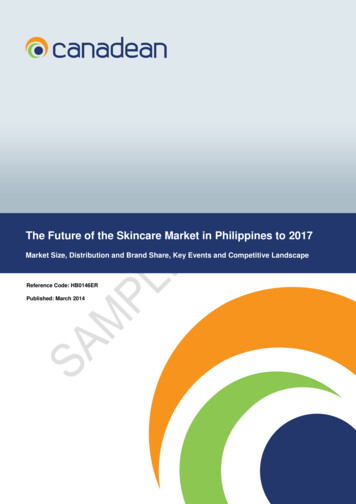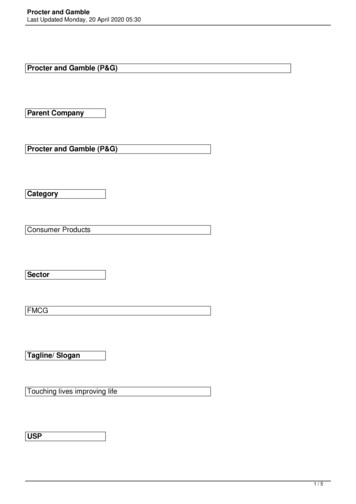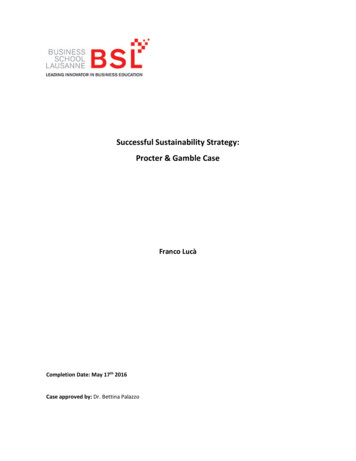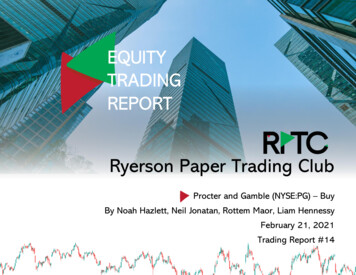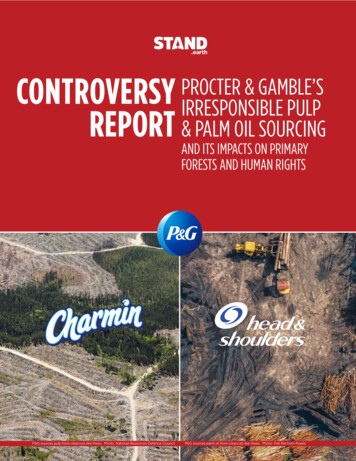
Transcription
PROCTER&GAMBLE’SCONTROVERSY IRRESPONSIBLE PULPREPORT & PALM OIL SOURCINGAND ITS IMPACTS ON PRIMARYFORESTS AND HUMAN RIGHTS1P&G sources pulp from clearcuts like these. Photo: National Resources Defence CouncilP&G sources palm oil from clearcuts like these. Photo: Pok Rie from Pexels
EXECUTIVE SUMMARYConsumer goods giant Procter & Gamble(P&G) is now embroiled in a growing numberof controversies stemming from its sourcing ofwood pulp and palm oil.1 These controversiesimplicate P&G in violating human rights,degrading primary forests and endangeringthreatened species for ubiquitous productslike toilet paper and soap. They also creatematerial and reputational risk for the company’sbrand equity, especially among socially andenvironmentally conscious consumers andinvestors.2 P&G has four key areas of controversylinked to its sourcing of pulp and palm oil:P&G sources from palm oil plantations that pose animmediate threat to nearby habitats like this.2
CONTROVERSY 1:P&G sources pulp from clearcuts like these. Photo: Kels Pitchenese, Eagle Lake First Nation in CanadaDESTROYING & DEGRADING PRIMARY FORESTS, INTACT FOREST LANDSCAPESFor its pulp and palm oil supplychains, P&G has failed to adopt andimplement mandatory policies andenforcement protocols that prohibitdeforestation and conversion ofnatural ecosystems, as well ashalt expansion into Intact ForestLandscapes (IFLs), old growth andprimary forests. It has also failedto commit to time bound goalsfor reducing forest fiber in tissueproducts. For example, the company: Purchases hundreds of thousands oftons of fiber annually from clearcut logging in primary and oldgrowth forests in British Columbia,and key boreal forests in Ontario,Alberta, and Quebec, rather thanadding recycled fiber to its singleuse name brand products such asCharmin toilet paper and BountyPaper Towels.3 Boreal forests storemassive amounts of carbon, andsingle use tissue products are thelast place these trees should end up.P&G uses zero recycled fiber in itstissue products, while competitorKimberly Clark uses an average ofnearly 30% with a goal to reach 50%recycled fiber by 2025. Sources palm oil from 22 Indonesianproducers engaged in on-goingpeatland destruction, some undergovernment indictment.3
CONTROVERSY 2:P&G purchases palm oil from suppliers that dramatically impact farmers like this. Photo courtesy of Rainforest Alliance Network, Farmers of Jambi Province, IndonesiaVIOLATING HUMAN RIGHTSIn regions affected by P&G’s fiberand palm oil sourcing, the companyseems comfortable perpetuatingcolonialist practices rather thanworking to build respectfulrelationships with frontline andIndigenous communities, affectedrights holders and the civil societyorganizations supporting them. P&Gdoes not require its suppliers todemonstrate that adequate policies,standard operating procedures andindependent verification mechanismsare in place to guarantee thatIndigenous Peoples and traditionalcommunities’ rights to free, prior,and informed consent (FPIC) arerespected. P&G has also failedto commit to Zero Tolerancefor Violence, Harassment andIntimidation. Examples of supplierviolations include: In Canada, some of P&G’s pulpsuppliers in BC, Ontario and Quebechave Free Prior and InformedConsent (FPIC) policies that fail toenforce non-compliance issues oroffer transparency to the Indigenouspeople who depend on theseforests, one of the fundamentalrights laid out in the United NationsDeclaration of Indigenous People. In Indonesia, Astra Agro Lestari(AAL) is implicated in ongoing landconflicts in rural areas in West andCentral Sulawesi. AAL’s subsidiariesallegedly seized land from thelocal communities without theirconsent and then felled forests tomake way for oil palm plantations.Impacted communities allege thatthe company has criminalized localcommunity members who haveresisted the takeover of their lands,leading to the wrongful incarcerationof several land defenders. Anothersupplier, Golden Agri Resources, islinked to corruption as executivesfrom its subsidiaries were sentencedto prison for bribing governmentofficials. A September 2020 investigationby the Associated Press found thatmore than one-hundred currentand former workers from twodozen palm oil companies had beencheated, threatened, held againsttheir will or forced to work offinsurmountable debts. Others saidthey were harassed by authoritiesand detained in governmentfacilities. In Malaysia, P&G’s palmoil suppliers4 like FGV and SimeDarby are linked to forced labor andhuman trafficking and U.S. Customsand Border Protection has blockedpalm oil imports from them. P&G has refused to meet withimpacted communities in conditionsthat guarantee their security andanonymity, and arbitrarily picks thecommunities it consults.4
CONTROVERSY 3:P&G sources pulp from clearcuts like these.PUTTING THREATENED AND ENDANGERED SPECIES AT RISKP&G continues to source fromsuppliers that degrade critical caribouhabitat, putting threatened cariboupopulations already on a trajectory ofdecline, at further risk. For example: In Ontario, Domtar is likelysourcing wood from the Sydneycaribou range, where the cariboupopulation is fewer than onehundred animals and declining pastthe point of no return. In Quebec, Resolute ForestProducts is likely sourcing woodfrom the Pipmuacan caribou rangein Quebec, where approximatelyone-hundred caribou eke out anexistence in habitat that is already68 percent disturbed, primarilyfrom logging, and being more andmore disturbed every year.5 In British Columbia, P&G sources arange of companies impacting oldgrowth and primary forests in theprovince. Some of the logging takesplace in critical caribou habitatincluding various endangeredherds.5
CONTROVERSY 4:P&G sources pulp from clearcuts like these. Photo: Kels Pitchenese, Eagle Lake First Nation in CanadaTRANSPARENCY & ACCOUNTABILITYP&G has failed to develop thesystems necessary to createtransparency and publicaccountability within P&G’s pulp andpalm oil supply chains. The company: Relies on third party certificationsystems to provide oversight andaccountability for its pulp supplyinstead of developing effective duediligence systems and infrastructurethat ensure intact primary forestsand threatened species habitat arenot in their supply chains. Despite the weaknesses of theindustry-controlled Roundtable onSustainable Palm Oil (RSPO), P&Gstill fell far short of its commitmentto achieve one-hundred percentRSPO certification of all palm oilprocessing facilities. Less than 10percent of P&G’s palm and palmkernel oil sourced in 2019 wasRSPO certified.6 Failed to meet the demands ofshareholders, 67% of whom votedin favor of a resolution put forwardby Green Century Equity Fundcalling on the company to report onhow and whether it can eliminatedeforestation and intact forestdegradation from its supply chain.76
P&G’S FAILURE TO DISTANCEITSELF FROM IRRESPONSIBLESUPPLIERS--SUPPLIERS THATVIOLATE HUMAN RIGHTS,DEGRADE PRIMARY FORESTSCONCLUSIONAND ENDANGERTHREATENEDSPECIES--HASBECOME AMATERIAL RISKTO P&G AND ITSINVESTORS.Consumer goods giant Procter &Gamble has knowingly and willfullyrefused to take full responsibility forits supply chain and failed to managethe reputational risk associatedwith its suppliers of pulp fiber andpalm oil. P&G’s failure to distanceitself from irresponsible suppliersthat violate human rights, degradeprimary forests and endangerthreatened species--has become amaterial risk to P&G and its investors.The ongoing controversy regardingits pulp fiber and palm oil sourcingwill continue to tarnish its brands,including Charmin, Bounty, andHead & Shoulders.P&G has the resources to growits capacities and lead its sector intruly innovative ways. It simply lacksthe will and follow through. Thesecontroversies will continue to hauntthem unless they make the kinds ofchanges that the planet and futuregenerations need.7
BODY OF REPORTFor years, mounting evidence indicates that Procter& Gamble is sourcing forest products from suppliersimplicated in environmentally irresponsible loggingand human rights abuses. Last October, 67 percent ofP&G’s shareholders responded by voting in supportof a shareholder resolution urging the companyto eliminate deforestation and forest degradationfrom its supply chain.8 Rather than demonstratingleadership by distancing itself from irresponsiblesuppliers and adding recycled fiber to its toilet paperand other tissue products, P&G responded to theshareholder revolt with a misleading marketingcampaign that failed to include a clear plan to end itsreliance on irresponsible and high risk suppliers.9P&G sources pulp from clearcuts like these.Photo: Kels Pitchenese, Eagle Lake First Nation in CanadaP&G’s management has chosen to retreat to tired oldtalking points about “replanting trees” and outsourcingsupply chain oversight to third-party certifications.10This leaves P&G right where it began—highlyexposed to suppliers that degrade intact primaryforests and critical habitats and fail to adequatelyprotect the rights of local and Indigenous peoples,particularly in Canada’s boreal forest and in palm oiloperations in Indonesia and Malaysia.The growing understanding of deforestation, forestdegradation, and human rights controversiesmeans most of P&G’s shareholders know that suchineffectual steps cannot prevent the destructionof intact primary forests and threatened specieshabitat and guarantee respect for human rights.More importantly, P&G’s obfuscation and inactioncreates significant reputational and financial risks thatundermines socially responsible investment funds thathold P&G stock.8
P&G CONTROVERSYIN CANADAProcter & Gamble purchased 523,900metric tonnes of wood pulp fromCanada in 2019-20 to make itsflagship brands Charmin toilet paperand Bounty paper towels.11 Thispulp is made from industrial-scalelogging operations that are drivingthe loss and fragmentation of forestsin boreal and mountain ecosystemsacross Canada. The boreal forest,in particular, is a climate-criticalecosystem known as the “Amazon ofthe North” that stores more carbonper hectare than just about any otherforest on Earth.12Both boreal andmountain forests are populated byhundreds of Indigenous communitiesand also home to an array ofwildlife species, including dozens ofwoodland caribou herds that werelisted as threatened or endangeredby the federal government in 2012.Federal guidelines also establishedthat these threatened caribou willhave a much greater chance atlong-term survival if their rangehabitat is 65% intact. However, P&Grefuses to commit to ensuring that itssuppliers adhere to this science-basedthreshold - essentially cementing theiracceptance of key threatened specieshabitat in their supply chains. This fliesin the face of the 85% of Americansthat want greener toilet paper.13ONTARIO ANDQUEBECEach year, Procter & Gamblepurchases approximately 500,000tonnes of pulp made from industrialforest-clearing in primary borealforests in Ontario and Quebec.These mills are owned by powerfulcompanies such as Aditya BirlaGroup, Domtar (Paper Excellence)13and Resolute Forest Products, someof the largest producers of pulp andpaper in the world, and they are keysuppliers of pulp to U.S. markets.Unfortunately, these companiesconsistently fail to implementcritical social and environmentalsafeguards, putting at risk therights of Indigenous communities,critical habitat for a federally listedthreatened species, and an importantstorehouse of carbon. And yetProcter & Gamble continues tosource its pulp from these companiesto make single-use products liketoilet paper while boasting about thesustainability of its operations.IMPERILING THREATENED CARIBOUPOPULATIONSAccording to a recent analysis byNRDC, these three companiessourced an average of 9.4 millioncubic meters of wood from borealforests in northern Ontario andQuebec.15 This wood comes fromboreal forest that is carved up byroads that allow for industrial-scalelogging, the primary threat to thehealth and persistence of Canada’sthreatened woodland cariboupopulations.Much of the wood supplying themills that make P&G’s pulp comesfrom forest units that encompasslegally designated critical habitatfor Canada’s threatened woodlandcaribou populations. To maintain andrecover these caribou populations,Canada’s 2012 caribou recoverystrategy indicates these forestsmust remain at least 65 per centundisturbed (i.e. only 35 per cent canbe altered by logging and wildfires).Aditya Birla Group, Domtar andResolute Forest Products likely aresourcing wood from several caribouranges (which each harbor severallocal populations) that are alreadyapproaching or beyond the 35 percent disturbance thresholds, beyondwhich caribou herds will continue todecline. In Ontario, Domtar is likelysourcing wood from the Sydneycaribou range, where the cariboupopulation is fewer than 100 animalsand declining past the point of noreturn.16 Their forest habitat is 64percent disturbed, almost twicethe sustainable limit.17 The cariboupopulation in the Churchill range (45percent disturbed) is also fewer than100 and declining, and the habitat isalready 35 per cent disturbed.18Resolute Forest Products, likewise,is likely sourcing wood from thePipmuacan caribou range in Quebec,where approximately 100 cariboueke out an existence in habitat thatis already 68 percent disturbed,primarily from logging, and beingmore and more disturbed every year.19Why is so much critical habitatof a federally listed threatenedspecies being destroyed by logging?Because the Ontario and Quebecgovernments have allowed too muchlogging to take place in federallydesignated critical caribou habitat.Inexplicably, Ontario has exemptedlogging operations from prohibitionsin its 2008 Endangered SpeciesAct against destroying habitat ofcaribou and other species at risk.20In 2018, the Quebec governmentannounced that it would not protectthe Val D’or caribou herd, whichexcessive logging and road buildinghad reduced to just 18 individuals,because it would be too expensive.21In late 2019, the Quebec Ministry ofForests, Fauna and Parks revokeda policy that protected 46,000hectares of critical caribou habitat sothat it could be logged.22FAILED CERTIFICATION SCHEMESIn practice, this leaves only forestcertification programs as the primarymeans of protecting caribou habitatoutside of protected areas. Forestcertification programs are, in theory,supposed to voluntarily imposestricter forest management practicesthan required by law. Only one,Forest Stewardship Council (FSC)certification, has standards that havethe potential to raise the bar abovestatus quo industrial clearcut logging.23But P&G still finds a way to cut corners.P&G has publicly committed to a“preference” for wood pulp fromForest Stewardship certified suppliers.Yet its commitment is misleading.The company exploits loopholes inthe FSC system, resulting in morethan half of its North Americanwood pulp (5.6 million cubicmeters) coming from non-FSCcertified forest units. That fiber issourced through some of the worstlogging practices in North America,including excessive spraying of9
toxic chemicals that poison people,water and wildlife, destruction ofcritical habitat for threatened andendangered species, and massiveclearcuts in old-growth forests.There is no requirement to obtainfree, prior and informed consentfrom Indigenous People whose landis being transformed into clearcutsand/or plantations, and there arenot adequate grievance systems forimpacted communities.24“CARIBOU ARE, SADLY,VERY SENSITIVE TOHUMAN DISTURBANCES,AND WE AREDISTURBING CARIBOUMORE AND MORE,”DR. JUSTINA RAY,WILDERNESS CONSERVATION SOCIETYCANADA PRESIDENT AND SENIOR SCIENTISTReliance on inadequate certificationschemes explains why caribouhabitat is being destroyed by P&G’ssuppliers. Of those public forest unitsthat are majority (i.e. more than 50per cent) caribou range habitat, only10 per cent (425,700 of 4.3 millioncubic meters) of the wood sourcedeach year by Aditya Birla Group,Domtar and Resolute Forest Productscombined is from FSC-certifiedforests.25 This means that the vastmajority of the wood being sourcedfrom critical caribou habitat is fromnon-FSC-certified forests, which putsthe caribou herds in these areas atsignificant risk of continued declineand extirpation.Resolute Forests Products, forinstance, sources 2.6 million cubicmeters of wood from non-FSCcertified public forest units that aremajority caribou habitat, and none ofthe wood sourced by Aditya Birla andDomtar in public forest units that aremajority caribou habitat isFSC-certified.26 In the Domtarmanaged Trout Lake Forest Unit,which is almost all critical caribouhabitat, logging has increased by 431percent in the last six years.27These three companies are justthe tip of the iceberg. Many moretimber companies also operate inand cut down Canada’s boreal forest,and decades of scientific researchhas made it very clear that widescale industrial logging continuesto reduce the size and resilienceof Canada’s caribou herds, despitethe fact they have been listed as“threatened” for two decades.INDIGENOUS RIGHTSThe continued decline of threatenedcaribou herds isn’t the only problemfrom such unsustainable loggingactivity in the boreal forest. SeveralFirst Nations have traditionalterritories and treaty rights in theboreal forest areas being loggedfor wood pulp. Aditya Birla Group,Domtar and Resolute Forest Productsmay have Free Prior and InformedConsent (FPIC) policies, but theyfail to provide transparency, ensurecompliance, and enforce noncompliance for the Indigenouspeople who depend on these forests,one of the fundamental rights laidout in the United Nations Declarationof Indigenous People.Eagle Lake First Nation, forinstance, is working to protect itstraditional lands on the FaraboutPeninsula in Eagle Lake, which isslated to be logged by non-FSCcertified Dryden Forest CompanyLtd. There are no caribou here,but it’s an unspoiled refuge ofbiodiversity full of thousands ofirreplaceable Indigenous cultural andarchaeological sites dating back 7000years. “The peninsula is sacred to us,”wrote Chief Arnold Gardner to theOntario Minister of Natural Resourcesand Forestry in 2018. “Any disruptionof these sites by the Dryden ForestManagement Company would bea violation of the Ontario HeritageAct” and “would violate Indigenousrights and would be an action ofremarkable cultural insensitivity.”28All of these inconvenient factsabout P&G’s sourcing of pulp fromCanada’s boreal forests are likelyonly going to get worse. Global pulpand paper giant Paper Excellence,headquartered in Richmond, BC,recently purchased Domtar. Domtaris now owned by a private companyrun by a family that is notoriousfor both human rights abuses anddeforestation.29 Transitioning from apublicly-traded company to a privateone could limit both transparencyand accountability and make it evenmore difficult for P&G to makegood on its unfulfilled promises ofsustainability.BRITISH COLUMBIAIn BC, industrial logging of intactforests is the primary reason forthe massive losses of old growthforests and steep declines in cariboupopulations over recent decades,particularly the threatened southernmountain population of woodlandcaribou. Southern mountain caribouonce roamed suitable habitat inall of SW BC, but today, only 17subpopulations hang on in a fractionof their historic range. Despite beinglisted under Canada’s Species at RiskAct in 2003, logging, as well as otherhuman activities and forest fires,has extirpated six subpopulations ofsouthern mountain caribou30 andthree additional population units arenow all but guaranteed to vanish fromthe face of the earth in the near future.In 2018, a scientific analysis indicatedthat 18 of 23 (78%) local populationunits were declining and 22 of 34(65%) subpopulations were less than100 individuals.31The central reason for these tragicdeclines and disappearances isthe destruction of caribou habitat,primarily by road building and clearcut logging of old growth and intactprimary forests. More than 900 sq kmof southern mountain caribou criticalhabitat was logged in BC during thefive years after it was identified in 2014,an estimated 50% increase in the areaof critical southern mountain caribouhabitat logged. Logging in old growthforests and caribou habitat continues10
EAGLE LAKE FIRST NATION CASE STUDYIn the heart of Ontario’s boreal forest, Migisi Sahgaigan (Eagle Lake) First Nation is arural Anishinaabe Ojibwe First Nation of about 700 people in northwestern Ontario,situated along the northeast shores of Eagle Lake, approximately 25 km southwest ofDryden.Historically, their livelihood consisted of fishing, hunting, trapping, gathering,harvesting wild rice, and horticulture. Today, the Eagle Lake First Nation’s economy isbased primarily on trapping, forestry and manufacturing, as well as employment in theservice sector.Cultural activities are as important to Eagle Lake society as economic affairs, andinclude pow-wows, ceremony, sharing circles, arts & crafts, traditional healing andElders’ activities. And at the center of it all is the land and the water they have occupiedfor thousands of years.“Everything that makes us up as people comes from the land,” says Miles Pitchenesewho works for ELFN Lands and Resources. “Our language comes from the land. We goout there to look for answers. The trees, rocks, water have spirits, too, and understand.We have to stop and listen and understand, and we have to make decisions not onlyfor us but also our great great grandchildren.”Several decades ago, members of the community started to notice logging crews andequipment, and large clear cuts soon followed. Logging companies cut trees right upto the edge of waterways and fly over spraying herbicides with helicopters, practicesthat demonstrate a blatant disregard for health, safety and sovereignty of Eagle LakeFirst Nation. Now they are trying to protect their traditional lands on the FaraboutPeninsula in Eagle Lake, which is slated to be logged by non-FSC-certified DrydenForest Company Ltd.“The biggest problem for the community is that irresponsible logging is changing howcommunity members interact with the land,” says Daniel Morriseau, also with ELFNLands and Resources. “It reduces what areas the people can interact with the landsafely. “Cutting to shore impacts fish habitat, water quality, changing wetlands andcanoe routes, and wild rice harvesting areas. It also affects food and medicinal plantgathering and how far community members have to go to harvest.”The forest destruction leaves “a sadness you can’t explain,” Morriseau laments.“You can’t understand why [the logging is] happening. It’s a tragic feeling to knowthat the impact on plants and animals will have a severe impact on the people. It’sheartbreaking.”Morriseau knows there are better, more sustainable forestry practices, and would likethe logging companies to work with Eagle Lake First Nation to implement the bestpossible practices: no cutting to shore, no spraying, no clearcutting and protectionsfor sacred sites and areas of intact forest.“The practices now are unsustainable,” he says. “P&G needs to hold itself to a higherstandard. Some forests are FSC certified, some are not FSC at all. FSC has the higheststandard for environmental and social. Those standards are not being adhered to.”WILL P&G HONOR THEIR RIGHTS AND WISHES?11
to threaten and extirpate southernmountain caribou populations.32Procter & Gamble admits on itswebsite to buying pulp from BC.33They purchase an estimated 25,000to 50,000 metric tons per year ofBC northern bleached (NBSK) kraftpulp from industrial logging in BC,or roughly 15% of the total volumeof NBSK pulp exports from BC to theUS.34 While the lack of transparencyin pulp supply chains makes it difficultto know with certainty from whomP&G buys it’s BC pulp, a reviewconducted by Stand.earth ResearchGroup of customs data, tradestatistics, investor presentations,corporate filings, company websitesand government data indicates pulpmills owned by Canfor and Mercerlikely constitute supplies the vastmajority of BC softwood pulp to theUS market, with most other BC millsfocused on Asian markets.According to an upcoming analysisbeing conducted by Stand.earthResearch Group, Canfor and Interfor(Mercer’s primary chip supplier - seebelow) are among the top loggers ofold growth forests in the province,and are active in several mountaincaribou herd ranges.35 Like their peersin Ontario and Quebec, these forestrycompanies have been certifiedby one or another third-partycertification schemes. (SFI, PEFC,FSC).36 Unfortunately, like Ontarioand Quebec, the lack of meaningfulgovernment regulations meansthese third-party certifications havebeen wholly ineffective at protectingold-growth forests, critical caribouhabitat and other environmentalvalues in BC.CANFORCanfor’s logging operations aroundPrince George are the primarysupplier for their NBSK pulp mills(Northwood and Intercontinental),Canfor claims that 100% oftheir supply comes from noncontroversial sources, avoidingwood harvested from areas thatthreaten high conservation valuessuch as endangered caribou.37However, Canfor’s currently activeand pending cutblocks, as pergovernment data, clearly overlapswith caribou habitat (see Map 1).This includes critical habitat ofmultiple southern mountain caribouherds east of their mills in PrinceGeorge: George Mountain, NarrowLake, North Caribou and the HartRanges. The George Mountain herdis already likely extirpated,38 andthe Narrow Lake herd is down toapproximately 40 individuals.39 TheNorth Cariboo herd has declinedfrom more than 275 in 2005 to about210 in 2016,40 while the Hart Rangesherd, the largest of the mountaincaribou ecotype, has experienceda 45% decline since 2006; the lastpopulation estimate in 2016 foundjust 375.41 And still Canfor logs incritical caribou habitat identified aspart of the recovery plan meant toprevent these herds from decliningfurther, including in old growth forest.“THE THREATS TOCARIBOU CRITICALHABITAT HAVEN’TREALLY CHANGED.IT’S UNSUSTAINABLELOGGING IN PRIMARYFORESTS, MOSTLY INWESTERN CANADA, ANDUNSUSTAINABLE OILAND GAS DESTRUCTIONOF CRITICAL HABITAT.”HEBBLEWHITECELGAR AND INTERFORIn 2019, Mercer’s Celgar mill,in Castlegar, BC, processedapproximately 2.3 million cubic metersof fiber, made from both whole logs(33%) and wood chips (67%).42 Celgar’schips are sourced from 30 differentsuppliers (primarily sawmills) in thesoutheast part of the province.43Interfor is the largest sawmiller in theregion around Celgar: it mills over onemillion cubic meters of logs annuallyat two facilities alone, accounting forover 40% of the lumber productioncapacity in the Selkirk Natural ResourceDistrict.44 Both of these mills are majorwood chip suppliers to Celgar,45 andone is located immediately adjacent toCelgar and supplies all itsco-product wood chips to the pulpmill. The majority of logs for thesesawmills come from Interfor’s nearbyforest operations, which overlapextensively with mountain caribouhabitat (see Map 2) and includesmany endangered southern mountaincaribou herds.Overall, of the 909 sq. km. of criticalsouthern mountain caribou habitat waslogged in the five years between 201419, which had been legally identifiedunder Canada’s Species at Risk Act(SARA).46 This includes forest habitat ofthe recently extirpated (locally extinct)South Selkirk herd47 located to the eastof Celgar (see Map 2).P&G’S ROLETo minimize its responsibility, P&Gclaims that lumber is really the driverof logging, not tissue products.48However, selling wood chips forpulp is so lucrative that even thelogging industry regularly refers toit as a “co-product” and not a “byproduct.”49 Furthermore, accordingto the government’s own data, BCpulp mills consumed about 5.8 millioncubic meters of whole trees in 2019,representing over 26% of their totalfiber input.50 For some mills suchas Mercer Celgar, the figure is evenhigher, as noted above (i.e. 33%).Regardless of whether the fiber usedby pulp mills comes directly fromforests (whole trees) or indirectly(wood chips from sawmills), BC pulpmills and the demand for pulp bycompanies like P&G are a key driver oflogging in caribou habitat, despite thefact the federal recovery strategy forwoodland caribou indicates no morecritical habitat should be disturbed.P&G’s Box Elder Mill in Utah and CapeGirardeau Mill in Missouri are amongthe P&G paper mills buying BC pulp.51These mills produce Bounty and12
00MAP 1Canfor'sCanfor’sPrinceCanfor'sPrince omCanfor'sloggingCanfor’slogging inin itatcaribou habitatRESEARCH GROUPKmKm50 100 15050 100 150Canfor Pulp millsCanfor Pulp millsCanfor SawmillCanfor SawmillCanfor Active & Pending CutblocksCanfor Active & Pending CutblocksCaribou Herd Risk StatusCaribouHerd Risk e OccurrenceTrace OccurrenceData Sources:BC tionalGeographicDataCatalogue,National Geographic13
0Mercer Celgar Pulp MillMAP 2Interfor SawmillInterfor Logging TenureMercer’s Celgar pulpmill’s sourcing fromInterfor’s logging incritical caribou habitatCaribou Herd Risk StatusRecently ExtirpatedEndangeredTrace OccurrenceData Sources:BC GovernmentData Catalogue,National GeographicKm50Mercer Celgar Pulp MillMercer's Celgar Pulp Mill'sInterforSawmillsourcingfrom Interfor's loggingin LoggingcriticalTenurecaribou habitatInterforCaribou Herd Risk StatusRecently ExtirpatedEndangeredRESEARCH GROUP25Trace OccurrenceData Sources:BC GovernmentData Catalogue,National GeographicMsouri14
Charmin brand tissue products. P&Ghas not done enough to ensure thatthese brands do not source fromhigh-risk supply chains. It matters verylittle if Bounty or Charmin is madefrom certified pulp, or if the pulp millsthat supply P&G claim to reduce theirenvironmental harm because if wepull focus from the
Procter & Gamble purchased 523,900 metric tonnes of wood pulp from Canada in 2019-20 to make its flagship brands Charmin toilet paper and Bounty paper towels.11 This pulp is made from industrial-scale logging operations that are driving the loss and fragmentation of forests in boreal and mountain ecosystems across Canada. The boreal forest,
